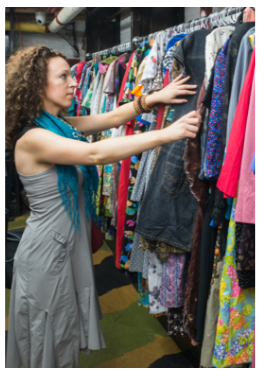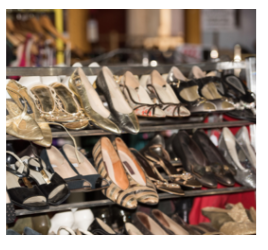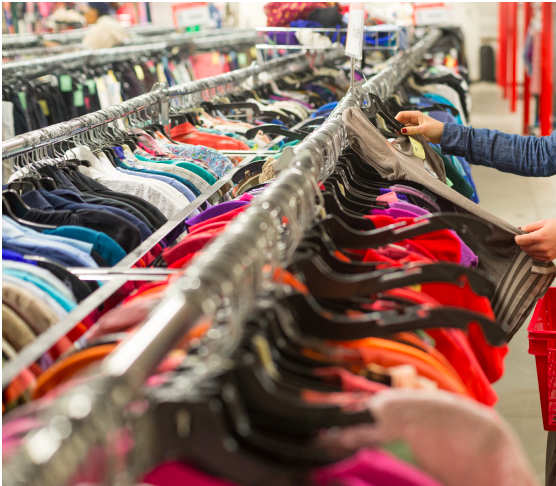Syndi Victor
Senior Staff Writer, Editorial Assistant
Who doesn’t love a bit of retail therapy? And which of us is not concerned about climate warming and the impact we are having on our environment? After all, we are all global citizens. This comes with an obligation to not only take care of ourselves but also take care of our world now and for future generations. Being environmentally conscious and doing our individual part to look after the Earth’s limited resources is something that we can incorporate into every aspect of our lives. So what is one single and simple way we can be part of the movement to care for our planet and our community while enjoying retail therapy and our pursuit of happiness? The name of this game is sustainability. If something is sustainable, it means that it can be done indefinitely. And the billion-dollar business of fashion is no exception.
You may have heard the term “sustainable fashion” but have you ever wondered what it actually means. It refers to the production of clothing and other consumables that could theoretically go on for centuries, with little negative impact on the environment. It means addressing the whole world of fashion as it operates within interdependent social, cultural, ecological and financial systems. Sustainable fashion, therefore, belongs to and is the responsibility of all citizens in both the public and private sectors.
Sustainable clothing refers to fabrics derived from eco-friendly resources, such as sustainably grown fiber crops or recycled materials. How to Spend It.com declares that sustainable clothing also refers to how these fabrics are made. One of the main reasons for the current, unsustainable condition of the fashion industry is related to the temporary disposable nature of products; the continuous stream of new products onto the market, or what is popularly called “fast fashion.”
Fast fashion has come to signify cheap, accessible and on-trend clothes, sourced through global production chains. Fast fashion adds to pollution and generates potential environmental and occupational hazards. The clothing industry has high water usage, pollution from chemical treatments used in dyeing and preparation. Add to this the widespread use of synthetic fibers, such as polyester which are plastic fibers and therefore non-biodegradable – they can take up to 200 years to decompose. Synthetic fibers are used in 72% of our clothing.
According to the article “Environmental Impacts of the Fashion Industry” by sustainyourstyle.org and The True Cost documentary, clothing has clearly become disposable. 32 billion garments are produced for the US market alone annually. A family in the western world throws away an average of 30 kg of clothing every year. Only 15% is recycled or donated, and the rest goes directly to the landfill or is incinerated as textile waste.
Characteristics of sustainable fashion match the philosophies of “slow fashion”. Coined by Kate Fletcher in her article “Slow Fashion” written for The Ecologist in 2007, the elements of the slow fashion philosophy include: buying vintage clothes, redesigning old clothes, shopping from smaller producers, making clothes and accessories at home and buying garments that last longer. Slow fashion represents a change in values and goals. It requires a changed infrastructure and a reduced throughput of goods. Slow fashion consists of durable products, traditional production techniques and design concepts that are season-less.

For workers in the textile industry in developing countries, slow fashion means higher wages. For end-users, slow fashion means that the goods are designed and manufactured with greater care and high-quality products. Sustainability is significant for fashion, because the textiles and fashion industry is among the leading industries that impact the environment negatively.
Historically, being environmentally conscious towards clothing was generally a marginalized practice and interest of a few. Primarily it meant buying clothes that were made from natural fibers, artisan or handmade and donating used clothing to charitable organizations for use by the poor or less fortunate in society. Today, with the loudly trumpeted trend towards sustainability and being ‘green,’ sustainable clothing has returned to the earlier values expressed by those formerly sidelined fashion activists. It has expanded to include a reduction of the amount of clothing discarded in landfills, and decreasing the environmental impact of agrochemicals in producing conventional fiber crops.
This has led to the emergence and growing popularity of Reusable Fashion as a huge part of sustainability efforts. To this end, “thrifting” has emerged as the most recognized reusable fashion practice and past-time for increasing sections of the population. Thrifting refers to the act of shopping at thrift stores, flea markets, garage sales, or a shop run by a charitable organization to raise funds for their activities. Thrifting appeals to older members of the population as well as young people who find thrift shops easily accessible and most likely to be affordable. In college towns especially, many young people and students don’t have a lot of money to shop for clothing and other items.
For the fashion and environmentally conscious, thrifting gives them a way to look stylish, save the planet and keep those dollars in their pockets. It is a simple, easy and fun way to do ones bit for our environment too. Thrifting has now attained the stamp of approval of aspiring “fashionistas” as companies specializing in the resale of high-end fashion items have taken to glossy, stylized advertising campaigns to attract customers. Elle magazine article “10 Actually Useful Thrifting Tips from Women Who Only Buy Used Clothes” (July 30, 2018) mentions some tips to get you started thrifting smart!

- It’s all about location -Thrift shops can range from very expensive to very inexpensive and the first, tend to be located in high-end areas. Try going to thrift stores in middle-class areas instead.
- Search for discounts – Check for discounts before you head to the store. Some stores have discounts on holidays and if you are a student, veteran, or teacher you can get even more clothes at a discounted rate. Goodwill and Salvation Army notably bring their bargains on certain mornings!
- Know the best times to go – Hit up thrift stores on a Wednesday instead of a Saturday to avoid stores packed to the brim with shoppers. This is also the time when you can find the best stuff.
- Learn what is fixable and what isn’t – If you pick up an item that has a large hole or pit stains, some of these things can’t be saved. On the other hand, it’s possible to fix something that’s scuffed, dirty, or just needs some simple sewing care.
- Most importantly, have fun! If you don’t have the time to go out and thrift then check online. ThredUp is the world’s largest online thrift store; they offer great fashions for low prices but remember that these are all second-hand items. Everlane is one of the most popular ethical brands on the market. The business operates primarily online but they pride themselves on their radical transparency.
NB. If you live in Atlanta, Georgia the following are some of the Thrift Stores you can visit:
- Buffalo Exchange
- Rag-O-Rama
- Labels Retail Boutique
- Psycho Sisters
- Goodwill
- Salvation Army

